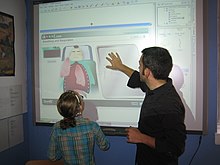Saturday, April 6, 2019
Tuesday, April 2, 2019
TO USE A VISUALIZER
Steps for Connecting a Laptop to a Projector
1. Make sure your computer and laptop are both turned off.
2. Connect the video cable (usually VGA) from your laptop’s external video port to the projector.
(Unsure what video output you have? View our video connection guide.)
(Unsure what video output you have? View our video connection guide.)
3. Plug your projector into an electrical outlet and press the “power” button to turn it ON.
4. Turn on your laptop.
5. If you need audio for your presentation, connect the laptop’s “audio out” port to the projector, or to another sound system.
6. Sync the projector and laptop by holding down the FUNCTION (Fn) key and pressing one of the following keys to toggle: F4, F5, F7, F8
INTERACTIVE WHITEBOARD
Jump to navigationJump to search
From Wikipedia, the free encyclopedia
An interactive whiteboard is a large, interactive screen that connects a computerand a projector. The projector projects the computer's desktop onto the screen of the interactive whiteboard. The user can control the computer by using a special pen, finger or another tool to touch the screen of the interactive whiteboard. Normally, interactive whiteboards are fixed on walls. However, there are some mobile interactive whiteboards. Interactive whiteboards are used in many different places such as in classrooms, in work groups and in training rooms for professional coaching. Interactive whiteboards are the modern version of the traditional whiteboards used in schools.
Operation[change | change source]
The interactive whiteboard must be connected to an PC before you can use the whiteboard. Most whiteboards are connected to the computer's Serial port or to a USB port. Some newer systems can use a wireless connection to the computer.
The summary of use the interactive whiteboard includes three words: controlling, translation and presentation.
- Controlling the PC means, that you can use the projection field like the desktop of the PC and the pen or the finger is the computer mouse.
- Most of the whiteboards translate the hand writing notes on the board in standard computer text. And so you can see your text clearly and save it as a file.
- Another use for interactive whiteboards is, that you can start presentations easily. You can start and control your presentation, although you stand in the front of the whiteboard and you are not depending on a keyboard.
Using interactive whiteboards[change | change source]
Teachers:
- They can write onto the board and save it as a document for use in the other lessons . You can also send the whole lesson or the documents via e-mail to pupils who were absent.
- Interactive whiteboard makes it easy to demonsate how to use new software
- Videos can be shown
For students:
- Fixing and changing ideas of a brainstorming easily is an resource which students can use to reach a success faster. When student can use modern technology they are more interested in learning.
Projection Systems[change | change source]
Front-projection: In this system the projector is placed in front of the whiteboard. Either the projector is fixed on the whiteboard or it hangs on the ceiling.
Pros
Compared to the rear projection this system is much cheaper
Cons
The teacher or the student must stand in front of the whiteboard and sometimes their body will cast a shadow.
Rear-projection: In the rear-projection system the projector is placed behind the whiteboard.
Pros
The teacher does not cast a shadow and does not look into the projector light while speaking to the students.
Cons
This system is very expensive.
VIDEO CONFERENCING
Video conferencing refers to conducting a video conference or video teleconference in which two or more sets of hardware and software interact while simultaneously transmitting and receiving video and audio signals from two or more geographic locations. Video conferencing may also involve sharing documents, various presentation materials, whiteboards, flip charts and similar group presentation visual aids. A telepresence system is most often used at the corporate or enterprise level and represents high-end video conferencing systems. Video conferencing is differentiated from video phone calls, which serve individuals as opposed to a conference. Video conferencing is also known as online video conferencing and PC video conferencing.
Video Conferencing
Video Conferencing
Video conferencing was established as early as the invention of the television, and consisted of two closed-circuit television systems using coaxial cable or radio transmission. NASA used video conferencing during the first manned space flight in 1961, with two radiofrequency links, one in each direction. TV news channels used the same technology for reporting from distant locations; thereafter, trucks with mounted satellite dishes provided mobile links for video conference transmissions. However, the technology was very expensive, so it was not used for business, education or telemedicine until many years later. By the 1980s, digital telephony became available using compressed video and audio transmissions. But it was not until 1984 that the first video conferencing systems were sold commercially by PictureTel Corp. In the 1990s, the expensive proprietary equipment that was previously required was replaced by new, standards-based technology for video conferencing, which became available to the general public at a much more reasonable cost. IP-based video conferencing also became possible around this time. The Winter Olympics of 1998 in Nagano, Japan, used the technology to broadcast part of the opening ceremonies across five continents in almost real time. In the 2000s, video conferencing became available at reasonable costs to any location with an Internet connection.
Subscribe to:
Comments (Atom)
